I woke immediately when the alarm went off at 5am. The pre-race nerves had arrived on Thursday lunchtime, and I had slept rather lightly on both Thursday and Friday night. I dressed quickly and started preparing a large breakfast of baked beans with sausages on toast, washed down by a cup of strong coffee. I would certainly need a lot of energy for the day, and I was hoping to reap the endurance-enhancing effects of the caffeine.
This is a real mountain race, with parts being an indistinct route across mountain ridges that are often shrouded in heavy cloud. Accordingly, the race rules require that all first timers compete as part of a two-person team, and that all individuals and at least one person from each team have been over the route before. This was my first time in the race, so I had teamed up with one of the guys from the harrier club – Mark McKone.
Mark arrived just after 6am. He was being very patriotic – wearing his club singlet over his polypro. I decided to take my singlet to put it on over my short sleeve polypro at the start. We arrived at the start area about 6:20am. With the sky heavily overcast it was still pitch dark, and the air was very cold for this time of year. The first order of the day was to convince the RD to let us start with the 7am bunch rather than the 7:45 bunch. In the end he agreed, an action for which we were very grateful come the end of the day. Having sorted that out, it was off to the gear check. Carefully packed bags were emptied for checking, then it was back to the car to repack. The air seemed to be getting colder, so I opted for a long sleeve polypro rather than the singlet over the short sleeve polypro that I was already wearing. After the final taping of toes it was off to the start line. We were both wearing hats and gloves to ward off the cold.
The run starts with a rocky track leading up a hill from the car park. It was easy to get separated from ones teammate with so many people along this stretch. I waited for Mark to catch up, and then we were off running at a fairly steady pace. We played leap frog with a couple of the women’s teams along the early section of the race – we would get ahead as we ran slightly faster, and then they would catch up as we stopped for photos or for a toilet stop.
The track up to the puffer saddle is well graded and has a good coating of gravel. Beyond that, however, the track rapidly becomes quite steep and is often bare clay which had become quite slippery after recent heavy rain. We reached the old Dobson’s hut site in a reasonably slow 50 minutes, and continued on to the “burn”. Beyond the Dobson’s. most of the route along Marchant ridge is through the beech forest. This makes for difficult travel over the twisted and exposed roots of the beech trees.
We reached the burn in about 1:20, and stopped for photos. The main part of Marchant ridge passed by reasonably uneventfully. We had an enjoyable time, traveling at a comfortable price, and seeing few other runners along the way. I ticked the waypoints off in my head as time ticked by. I couldn’t remember the times I had estimated for each of the major waypoints, but I was sure we were a bit on the slow side. Never mind, we should be able to pick up a lot of extra time over the tops and down the other side.
One thing about these sort of races is that you start to recognize the regulars. Harriette Carr, whom I had run with for a while at the start of the Korokoro half marathon, caught up to us not long before Alpha Hut. We chatted for a short while before we reached the hut.
I was still feeling quite fresh when we reached Alpha Hut, although I noticed that we were going rather slowly, being a few minutes behind my 9 hour schedule. Never mind, it was time to get down to the serious business of refilling water bottles and preparing for the tops. I decided to add my raincoat and put my hat and gloves back on . With the queue at the water tank, the longest task was refilling the hydropod bladder. Mark took a call on his cellphone (!!), and then we sent Angelene a text message so that she could tell what time we were likely to finish.
It immediately became much colder as we climbed above Alpha hut. Once we reached the open tops it was freezing cold with driving rain. I quickly decided that it was time to put on the polypro long johns. Some time after that I decided to add the over trousers as well. That makes three times out of four where I have had to stop soon after the hut to put on extra gear for the tops. Perhaps there’s a lesson here …
The rain on the tops was relentless and, as can be seen from the photo at the left, the track was a bog. To top it all off the cold and the caffeine were getting to my kidneys, and I had to make several pit stops along the way.
The rain on the tops was relentless and, as can be seen from the photo at the left, the track was a bog. To top it all off the cold and the caffeine were getting to my kidneys, and I had to make several pit stops along the way.
Visibility was severely restricted, down to perhaps 50m or less at times. It made it difficult to tell exactly where we were, and I lost count of which peak we were on. Judging by the time on my watch I thought that this climb must be the climb to Hector … it was. We stopped for some more photos at the memorial cross.
Only one more climb left and then we’ll be at Kime Hut. Before long, the flags erected by the race marshals near Kime appeared out of the cloud. I must have been a little disoriented, however, as the hut suddenly appeared in front of us from quite a different direction from what I had been expecting. Time for a warm fruit juice while Mark removed the stones from his shoes. The SAR people had one runner in a sleeping bag in the hut – apparently he was hypothermic when he arrived at the hut. We were advised at the prize giving that he was alright and was being walked out.
The journey out from Kime was mostly downhill all the way, and soon we were out of the thick cloud. From there it was quite pleasant, although Mark was starting to feel the effects of being on his feet for so long. He was asking “how much longer” at exactly the same places I had been asking the same question a month earlier. It was certainly somewhat easier knowing what lay ahead.
All hope of anything near 8 hours had well and truly gone by now. But, by the time we reached Field Hut we had made up sufficient time to be back on track for a 9 hour finish. Last time I was at Field Hut I was feeling rather tired and stopped to chat with some trampers. This time it was just a stop to remove excess layers – off with the long sleeve polypro and long johns, and my club singlet went on over my short sleeve polypro. Although the stop was slower than I would have liked, we still managed to save 9 minutes.
Nearing the Forks the long downhill was starting to take its toll on tired legs. The quads were getting quite sore, and both of us were slowing on the downhills. The finish line was visible in the distance, but there was still a good 10 minutes to get there.
As we got down to the grassy flat, I edged ahead of Mark in an attempt to drag us over the finish line in under 9 hours. We succeeded – we made it down the last hill, across the bridge and to the finish line in 8:57:22.
Although we had been an hour slower than I had hoped, and the weather on the tops was atrocious, it was a year for records to tumble. Some records fell by as much as an hour. The open men’s record may have been the only record one not to fall: Colin Rolfe had a bad year – having injured himself at Kaweka in mid Feb – and only (!!) managed 4:45 compared to his race record of 4:32. Jenny Cossey and Harriette Carr broke their women’s team record for the fourth year in a row.
| From | To | Duration | Total |
| Kaitoke | Old Dobson's Hut | 0:50:07 | 0:50:07 |
| Old Dobson's Hut | Block XVI Track | 1:40:11 | 2:30:18 |
| Block XVI Track | Bull Mound Track | 0:39:51 | 3:10:09 |
| Bull Mound Track | Alpha Hut | 0:41:06 | 3:51:15 |
| Alpha Hut | 0:10:58 | 4:02:13 | |
| Alpha Hut | Mt Hector | 2:02:03 | 6:04:16 |
| Mt Hector | Kime Hut | 0:30:04 | 6:34:20 |
| Kime Hut | 0:07:13 | 6:41:33 | |
| Kime Hut | Field Hut | 1:05:25 | 7:46:58 |
| Field Hut | 0:06:08 | 7:53:06 | |
| Field Hut | Otaki Forks | 1:04:16 | 8:57:22 |
Food consumed: breakfast – 420g can baked beans with sausages on two slices of molenberg toast, washed down with a mug of coffee (3,630 kJ); during the run – 11 Leppin squeezys, 3 “double caffeine” tangelo Powergels, 2 bananas (6,793 kJ); after the run – 600ml Powerade, 2 filled rolls (2,404 kJ); total 12,827 kJ.
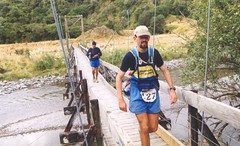
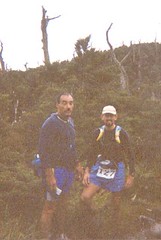
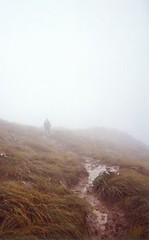

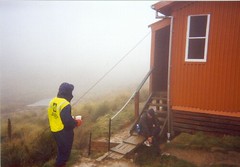
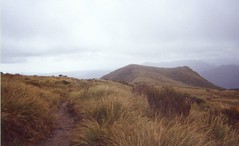
0 comments:
Post a Comment